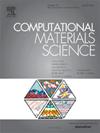低压下氢化铂的结构预测和声子介导的超导性:第一原理计算的启示
IF 3.1
3区 材料科学
Q2 MATERIALS SCIENCE, MULTIDISCIPLINARY
引用次数: 0
摘要
超导(SC)是凝聚态物理学领域中最引人入胜、最具影响力的现象之一,因此优先探索超导是至关重要的。我们的研究目的是阐明铂氢化物的金属态,这是预测其超导行为的关键一步。在这项研究中,我们利用第一原理计算结合进化算法,探索了铂氢化物在低压条件下的热力学稳定构型。我们的研究结果揭示了几种以前从未报道过的热力学稳定相,特别是 PtH 和 PtH。为了评估这些材料中 SC 的潜力,我们的研究揭示了 PtH 在 10GPa 压力下的 14.7K 和 PtH 在 10GPa 压力下的 19.5K。根据艾伦-戴恩斯修正麦克米兰方程的求解,我们深入了解到整体电子-声子耦合参数的大幅上升与带宽函数所显示的相对适中的截止频率有关。我们的发现意味着,PtH 和 PtH 在实验可达到的较低压力下表现出超导特性,值得合成并随后在实验室环境中测量其超导特性。本文章由计算机程序翻译,如有差异,请以英文原文为准。
Structural predictions and phonon-mediated superconductivity in platinum hydride under low pressure: Insight from first-principles calculations
Prioritizing the exploration of superconductivity (SC) is paramount, given that it constitutes one of the most intriguing and consequential phenomenon within the realm of condensed matter physics. Our study aim is to elucidate the metallic state of platinum hydrides, a critical step in predicting its superconducting behavior. In this study, we utilize first-principles calculations combined with an evolutionary algorithm to explore the thermodynamically stable configurations of platinum hydrides under low-pressure conditions. Our results reveal several thermodynamically stable phases that have not been previously reported, specifically PtH and PtH. To assess the potential for SC within these materials, our examination unveils that PtH demonstrates a of 14.7K, whereas PtH attains 19.5K at a pressure of 10GPa. Following the solution of the Allen–Dynes modified McMillan equation, we gain insight into a substantial rise in the overall electron–phonon coupling parameter linked to a relatively modest cutoff frequency, as indicated by a bandwidth function. Our discoveries imply that PtH and PtH, exhibiting SC at lower pressures that are experimentally reachable, merit synthesis and subsequent measurement of their superconducting properties in a laboratory environment.
求助全文
通过发布文献求助,成功后即可免费获取论文全文。
去求助
来源期刊

Computational Materials Science
工程技术-材料科学:综合
CiteScore
6.50
自引率
6.10%
发文量
665
审稿时长
26 days
期刊介绍:
The goal of Computational Materials Science is to report on results that provide new or unique insights into, or significantly expand our understanding of, the properties of materials or phenomena associated with their design, synthesis, processing, characterization, and utilization. To be relevant to the journal, the results should be applied or applicable to specific material systems that are discussed within the submission.
 求助内容:
求助内容: 应助结果提醒方式:
应助结果提醒方式:


